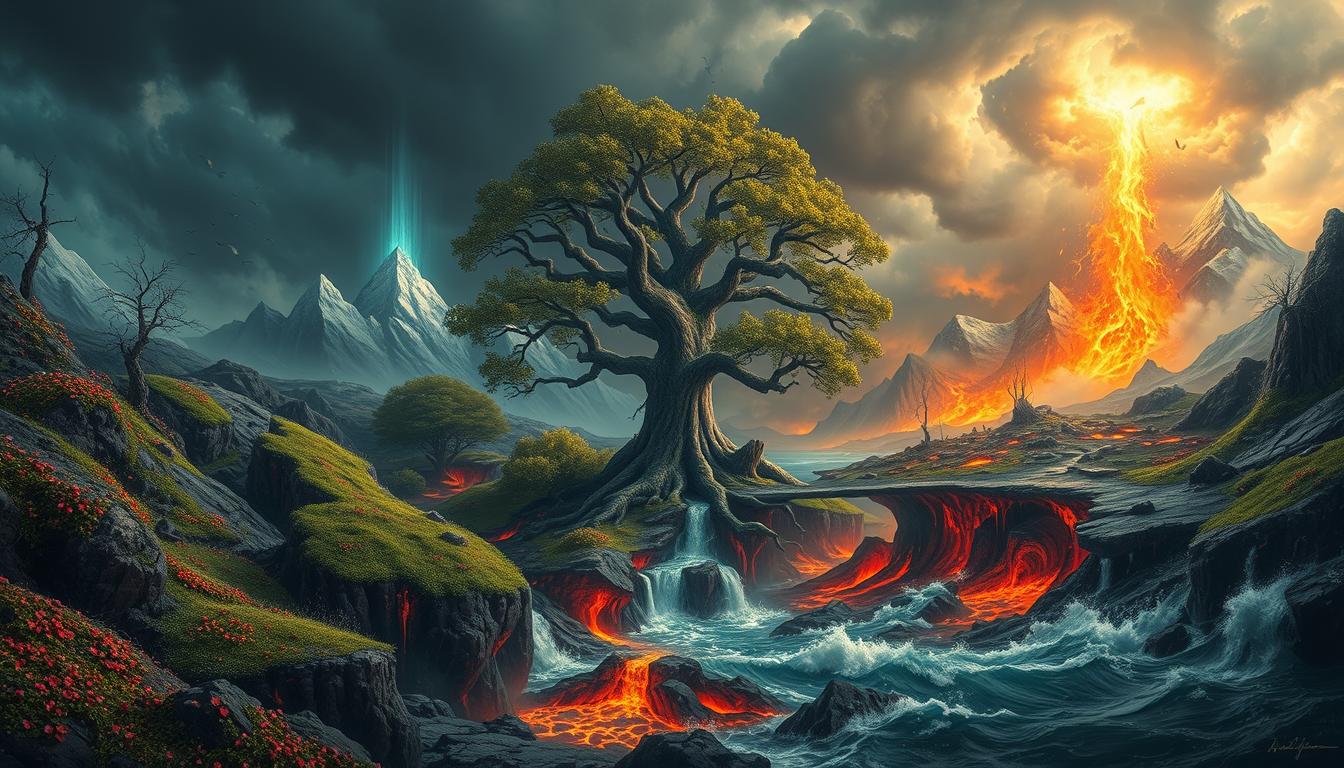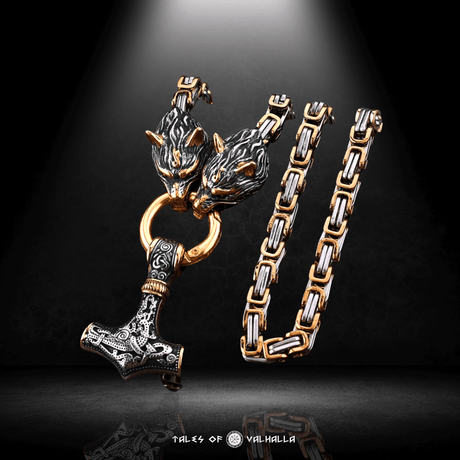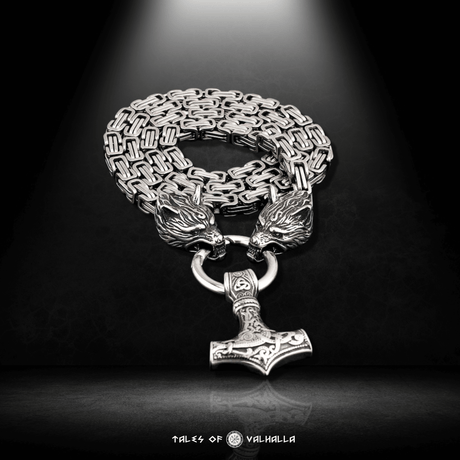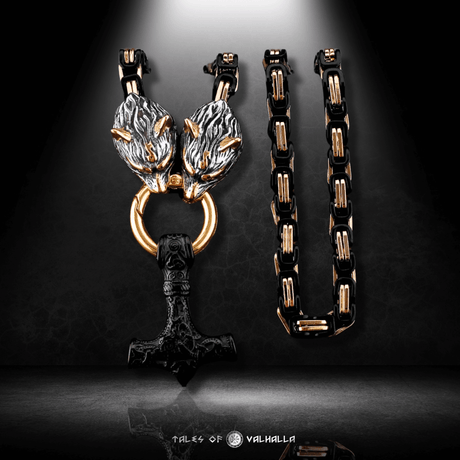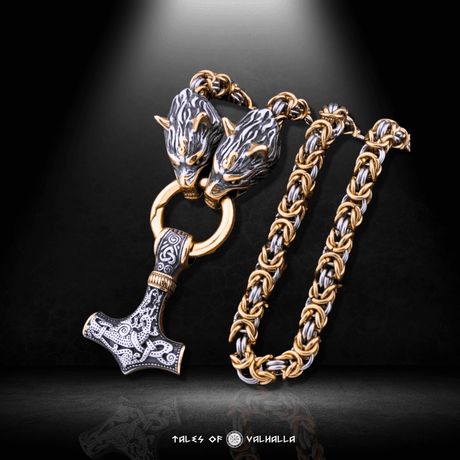The battle of Ragnarok was not the end of the Norse cosmos. It was a turning point, marking the end of the old world and the start of a new one. The surviving gods, new realms, and the rebirth of the world followed.
Norse mythology sees existence as a cycle. Ragnarok was the end of one cycle, leading to a new beginning.
The Aftermath of the Norse Apocalypse
After Ragnarok, the Nine Worlds of Norse mythology were in ruins. Destruction was everywhere, with gods and mortals' realms turned to ash. Asgard, the gods' home, was destroyed by Surtr, the fire giant.
The world tree, Yggdrasil, was shaken to its roots. This connected the Nine Worlds.

The Aftermath of the Norse Apocalypse
The gods were not spared. Odin, Thor, and Tyr fell in battle. Fenrir, Jörmungandr, and Loki caused chaos before their deaths.
The earth was covered in seas, with only a few islands left. The sun and moon were eaten by wolves. The stars fell, and the air was filled with smoke and ash.
The death-fated gods
Their doom they met,
And the lives of the giants
Likewise were lost.
But there was hope. Ragnarok's end meant a new start. Víðarr and Váli, the gods' sons, survived to help in the renewal. The earth would rise from the seas, and a new world would begin.
The Norse apocalypse marked the end of an era. Yet, it was not the end of everything. A new order would come, shaped by renewal and life's strength. Ragnarok's aftermath showed the cycle of creation and destruction in Norse mythology.
Surviving Gods and Their Roles
After Ragnarok, a few gods come out of the chaos to start anew. The sons of Odin and Thor are among them. They have big roles in the future of the universe.
Vidar and Vali, Odin's sons, make it through the battle and lead the new world. Vidar is strong and brave, and he kills Fenrir to avenge his father. He stands for justice and honor. Vali, on the other hand, fights for his family and shows the power of love.
Thor's sons, Modi and Magni, also survive and get Mjolnir, Thor's hammer. They protect the new world from dangers. Modi is brave, and Magni is mighty, showing the strength needed to rebuild.
The gods surviving Ragnarok show the cycle of Norse mythology. They lead, protect, and symbolize hope. This gives the new world a chance to grow and succeed.
"The gods who survive Ragnarok, particularly the sons of Odin and Thor, play a vital role in the rebirth of the world. They bring with them the wisdom, strength, and courage needed to guide the cosmos into a new era of peace and prosperity."
The surviving gods remind us that even after great destruction, we can start anew. Their actions after Ragnarok give us hope and inspire us today.
The Fate of the Fallen Gods
After Ragnarok, the gods of Norse mythology faced their final ends. Odin, the All-Father, was eaten by the wolf Fenrir. His wisdom and power couldn't change his fate, as the prophecy said he would die in the battle.
Thor, the god of thunder, fought the Midgard Serpent, Jörmungandr. Thor killed the serpent but died from its venom. He took only nine steps before falling, leaving a big loss for the gods and the world.
Tyr, the god of war, died fighting the hound Garm. He was known for his bravery and had lost his hand to Fenrir. His death during Ragnarok made him a hero of justice.
Heimdall, the god of vigilance, and Loki, the trickster, killed each other. Heimdall blew his horn to start Ragnarok. Their fight showed the end of order and chaos.
The death of these gods was a big change in Norse mythology. Their sacrifices helped the world start anew. Their bravery and wisdom remind us of the ongoing battle between good and evil.
The Rebirth of the World
After Ragnarok, the world was reborn, filled with new realms and a fresh cosmic order. The destruction from the battle opened a door for life to start anew. Yggdrasil, the world tree, was key in this rebirth, connecting all realms.
As the world settled, survivors saw a new world emerge. It was full of beauty and life. The land was green, with flowers everywhere. Streams flowed, making the soil fertile and feeding all living things.
Yggdrasil, damaged by Ragnarok, began to heal. Its branches touched the sky, its roots dug deep, and its trunk stood strong. It became a symbol of life and renewal, linking all realms together.
From the ashes of the old world, a new one arose, filled with promise and potential. The cycle of creation and destruction, so integral to Norse mythology, had come full circle, and the rebirth of the world marked the beginning of a new era.
The gods who survived Ragnarok, including reborn Balder and Hod, took their roles in the new world. They worked to bring order and balance, learning from past mistakes. The rebirth showed the power of life, hope, and the Norse cosmos' spirit.
The Survival of Humans
During Ragnarok, humans play a key role in Norse myths. Lif and Lifthrasir, a human couple, survive by hiding in Yggdrasil's branches. This World Tree connects the Nine Worlds, keeping them safe from the chaos.
Lif and Lifthrasir's survival is very important in Norse myths. They show humanity's strength and ability to keep going, even when everything seems lost. Their story tells us that life always finds a way, no matter how bad things get.
When the battle ends, Lif and Lifthrasir come out of their hiding place. They are tasked with repopulating the earth. As the only survivors, they bring hope for a new start and a chance to rebuild.
From their offspring shall the earth be peopled.
The story of Lif and Lifthrasir shows the cycle of Norse mythology. Just like the gods and the world, humans get a second chance after Ragnarok. This idea of renewal is a big part of Norse myths, showing that every end marks a new beginning.
Lif and Lifthrasir's survival after Ragnarok gives us hope. They represent humanity's spirit and the promise of a new beginning. As their descendants fill the earth, they carry on their ancestors' legacy and the lessons of the apocalypse, starting a new chapter in Norse mythology.
The New Sun and Moon
After Ragnarok, a new era begins. A new sun and moon appear, bringing renewal and hope. In Norse myths, the old sun and moon were eaten by wolves. But their children live on.

The New Sun and Moon
The Poetic Edda tells us about Sól and Máni's daughters. These girls will light up the sky, just like their parents did. They are the new sun and moon, shining on a world reborn.
This cycle shows the world's endless struggle. It's about creation and destruction. The new sun and moon remind us that life and light always come back.
"In the sky shall shine the maiden who takes her mother's paths, when the Powers die." - Völuspá, The Poetic Edda (Translated by Jackson Crawford)
The new sun and moon bring order back to the world. They mark time and life's cycles. Under their light, the new world grows, showing the Norse universe's strength.
The new sun and moon after Ragnarok are key to Norse myths. They show us that even in tough times, there's always hope for a new start. The daughters of Sól and Máni light up the sky, welcoming a new era of growth and healing.
The Fate of the Monsters
After Ragnarok, the monsters that fought in the battle faced their own ends. Surtur, the fire giant, set the world ablaze, causing its destruction. He was then engulfed by the flames he started, ending his life.
Jormungandr, the World Serpent, clashed with Thor, the god of thunder. Thor killed the serpent but died from its venom soon after. Jormungandr's death upset the world's balance, as it was a key part of it.
Fenrir, the giant wolf, was defeated by Vidar, Odin's son. Vidar, known for his strength, avenged his father's death by tearing Fenrir apart. This victory showed order's triumph over chaos, even in Ragnarok's destruction.
The fate of these monsters shows the cycle of Norse mythology. Their deaths led to the world's rebirth and a new cosmic order.
With Surtur's flames gone and the dust settled, the world lay in ruins. The monsters that once threatened it were now gone. Their fate reminded us of change's inevitability and the eternal battle between order and chaos in Norse myths.
The Transformation of the Cosmos
After Ragnarok, the Norse apocalypse, the world changed a lot. The old world, damaged by the gods and giants' fight, was replaced by a new one. Gods like Vidar and Vali came out to start over.

The Transformation of the Cosmos
This new start was a chance for peace and harmony. The old world was full of fights. Now, the gods aimed to make a lasting, peaceful world.
The new world was full of beauty and wonder. The earth was green, and the sun was bright. Gods built new homes, and people started to rebuild their lives.
The earth shall emerge out of the sea, and shall then be green and fair; crops will grow unsown, and all sorrows will be healed.
This quote from the Poetic Edda talks about the new world. It's a place where the earth is beautiful, and all troubles are gone. This world shows a balance between creation and destruction, unlike the old one.
The change after Ragnarok is key in Norse myths. It shows life can start again after big disasters. The new world shows the strength and spirit of gods and humans.
The Legacy of Norse Mythology
Norse mythology has a lasting impact on our culture today. It has influenced many stories, from old Viking poems to modern movies and TV shows. The stories of gods, giants, and Ragnarok still captivate us, showing the power of these ancient tales.
The idea of life's cycles is a big part of Norse mythology's appeal. Ragnarok's story of destruction and rebirth speaks to people everywhere. It inspires creators to share these timeless themes with new audiences.
Authors like J.R.R. Tolkien and Neil Gaiman have been influenced by Norse myths. Tolkien's "The Lord of the Rings" has a ring that must be destroyed, like Heimdall's role. Gaiman's "American Gods" and "Norse Mythology" bring Norse gods into today's world, showing their lasting importance.
Norse mythology also shapes popular culture. Films, TV shows, and games like Marvel's Thor and "God of War" draw from its stories. These works take creative liberties but keep the essence of Norse myths alive for us today.
The Norse gods are not remote, all-powerful beings but flawed characters, prone to hubris, passion, and tragedy. They are, in short, recognizably human, despite their divine status.
The gods of Asgard are relatable because they are flawed and complex. They deal with loyalty, honor, and destiny, just like us. This makes them more than just gods, making their stories resonate with us.
Exploring Norse mythology reminds us of storytelling's power. Ragnarok's themes of destruction and rebirth inspire us. It shows the human spirit's strength in dark times, a legacy that will keep inspiring us.
The Eternal Cycle of Creation and Destruction
In Norse mythology, the eternal cycle of creation and destruction is key. Ragnarok shows this cycle, revealing the Norse view of the universe. They saw destruction as a step in the cosmic cycle, not the end.

The Eternal Cycle of Creation and Destruction
The Norse thought the world started from nothing, made by gods. After Ragnarok, a new world began, with life starting over. This cycle continues.
Their view of life came from nature. They saw seasons change, life cycles, and landscapes shift. Ragnarok was the ultimate example of this cycle.
Just as the winter gives way to spring, and the old generation is replaced by the new, the Norse saw the end of one world as the necessary prelude to the birth of another.
Some gods and humans survived Ragnarok. This shows life's continuity and renewal. The new world was shaped by those who lived through the disaster.
The cycle of creation and destruction in Norse mythology teaches us about life's fleeting nature. It shows life's strength and offers a timeless view of existence.
The Significance of Renewal and Hope
After Ragnarok, the Norse apocalypse, a message of renewal and hope shines through. The world's rebirth and the survival of gods and humans show life's strength. Even when faced with huge challenges, life finds a way to continue.
Norse mythology deeply values renewal. Ragnarok, though devastating, is just a step in the eternal cycle. It leads to a new start. This idea of rebirth gives us comfort and hope, showing us that even in the darkest times, we can grow and change.
Gods like Vidar, Vali, Modi, and Magni, along with humans Lif and Lifthrasir, symbolize hope. They light the way in darkness, showing life's strong spirit. Their presence after Ragnarok gives us hope for a better future, no matter how dark things seem.
The world's renewal, with a green earth emerging from the sea, shows nature's power. It reminds us that life can start anew, even when all seems lost. This gives us hope and the chance for a fresh start.
The Norse myth of Ragnarok, with its themes of destruction and rebirth, serves as a powerful allegory for the human experience, reminding us that even in the face of great adversity, there is always the potential for renewal and the promise of a better tomorrow.
The importance of renewal and hope after Ragnarok cannot be overstated. These themes, woven into Norse mythology, share a timeless message. They remind us to hold onto hope, even in our darkest moments. They tell us that a new day will come, bringing the chance to rebuild, grow, and thrive.
Comparing Ragnarok to Other Apocalyptic Myths
Ragnarok, the Norse apocalyptic myth, has similarities with other end-of-world stories. These myths talk about the world's destruction and then its renewal. By looking at Ragnarok alongside other myths, we understand universal themes and human fears.
The Hindu "Yuga Cycle" shows a cycle of creation and destruction. Like Ragnarok, it ends with destruction and then starts anew. This shows the cycle of life and the belief in change.
The Aztec legend of the "Five Suns" is another comparison. It tells of four worlds destroyed before our current one. This mirrors Ragnarok's prophecy of the world's end and the hope for a new start.
"The study of apocalyptic myths from around the world reveals the shared hopes, fears, and beliefs that have shaped human culture and imagination throughout history."
The Greek myth of the "Titanomachy" also shares similarities with Ragnarok. It's about a battle between gods that changes the world. This shows that even gods face change and renewal.
By looking at Ragnarok and other myths, we appreciate human concerns. These stories remind us of our hopes and fears. They show our belief in renewal and rebirth, even in the face of disaster.
The Impact of Christianity on the Ragnarok Narrative
During the Viking Age, Christianity spread through Scandinavia. This had a big impact on Norse mythology and the Ragnarok narrative. The impact of Christianity on what happened after Ragnarok is especially interesting. It shows how Christian beliefs and themes might have changed the story's recording and interpretation.
Christianity brought new themes like judgment and salvation to the Ragnarok story. In Christian beliefs, the world's end is tied to a final judgment. The righteous go to heaven, and the wicked to hell. This idea of a final reckoning might have appealed to the Norse people as they thought about Ragnarok's aftermath.
Christianity also emphasized moral behavior and the consequences of actions. In Norse mythology, the gods and humans' choices led to Ragnarok. The story's aftermath showed the effects of these choices. This idea of personal responsibility is key in Christianity and might have influenced the Norse view of Ragnarok's aftermath.
Yet, the Ragnarok story kept its Norse roots and themes. The cycle of the cosmos, fate, and the gods' roles were still central. Even as Christian ideas entered the Norse worldview, these elements remained core to the tale.
"The old gods may have fallen, but the spirit of the Norse people endured, forever shaped by the tales of Ragnarok and the promise of a new beginning."
As Christianity's influence grew, the Ragnarok narrative likely changed. But its core – the epic battle, the world's destruction, and the hope for renewal – stayed strong. It showed the lasting power of Norse mythology and its ability to inspire many generations.
Ragnarok in Popular Culture
The epic tale of Ragnarok has captured the imagination of audiences far beyond its Scandinavian roots. It has inspired numerous modern adaptations in popular culture. From films and television shows to video games, the Norse apocalypse has been reimagined and reinterpreted for contemporary audiences.
In the realm of cinema, the Marvel Cinematic Universe has drawn heavily from Norse mythology. The character of Thor and his home realm of Asgard play central roles in films like "Thor: Ragnarok." This blockbuster adaptation showcases a vibrant, action-packed version of the apocalyptic event.
Video games have also embraced the concept of Ragnarok. Titles like the "God of War" series weave the Norse apocalypse into their narratives. The latest installment, "God of War: Ragnarök," directly addresses the aftermath of the cataclysmic event.
These modern adaptations of Ragnarok have not only entertained audiences but have also sparked a renewed interest in Norse mythology. By bringing these ancient tales to life through the power of visual media, popular culture has ensured that the legend of Ragnarok continues to captivate and inspire people around the world.
FAQ
What is Ragnarok in Norse mythology?
Ragnarok is the Norse apocalypse. It's when the world ends and many gods die, like Odin and Thor. It's a big battle that destroys the world, but then it's reborn.
Which gods survive Ragnarok?
Gods like Vidar and Vali, Odin's sons, and Modi and Magni, Thor's sons, survive. They help rebuild the world after the big event.
What happens to the world after Ragnarok?
After Ragnarok, the world is reborn. The tree Yggdrasil is fixed, and the world is beautiful and fertile again. This shows the cycle of creation and destruction in Norse myths.
Do any humans survive Ragnarok?
Yes, Lif and Lifthrasir, a human couple, hide in Yggdrasil and survive Ragnarok. They start the new world by repopulating it.
What happens to the sun and moon after Ragnarok?
The sun and moon are replaced by Sól's and Máni's children after Ragnarok. This shows the cycle of time in Norse myths.
What is the fate of the monsters after Ragnarok?
Monsters like Surtur and Fenrir are defeated and destroyed in Ragnarok. Their death helps renew the world and start a new order.
How has Norse mythology influenced modern culture?
Norse myths, especially Ragnarok, have shaped modern culture. They've inspired many books, movies, TV shows, and games, like "God of War."
What is the significance of renewal and hope in the Ragnarok story?
Ragnarok's rebirth and survival of gods and humans show renewal and hope. Even with destruction, life goes on, starting a new era. It shows the universe's resilience.

